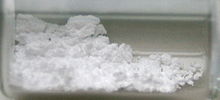Loading AI tools
Chemical compound From Wikipedia, the free encyclopedia
Europium(III) oxide (Eu2O3), is a chemical compound of europium and oxygen. It is widely used as a red or blue phosphor in television sets and fluorescent lamps, and as an activator for yttrium-based phosphors. It is also an agent for the manufacture of fluorescent glass. Europium fluorescence is used in the anti-counterfeiting phosphors in Euro banknotes.[2]
 | |
| Identifiers | |
|---|---|
3D model (JSmol) |
|
| ChemSpider | |
| ECHA InfoCard | 100.013.787 |
PubChem CID |
|
| UNII | |
CompTox Dashboard (EPA) |
|
| |
| |
| Properties | |
| Eu2O3 | |
| Molar mass | 351.926 g/mol |
| Appearance | white to light-pink solid powder |
| Odor | odorless |
| Density | 7.42 g/cm3 |
| Melting point | 2,350 °C (4,260 °F; 2,620 K)[1] |
| Boiling point | 4,118 °C (7,444 °F; 4,391 K) |
| Negligible | |
| +10,100·10−6 cm3/mol | |
| Thermal conductivity | 2.45 W/(m K) |
| Structure | |
| cubic, cI80, Monoclinic | |
| Ia-3, No. 206, C2/m, No. 12 | |
| Hazards | |
| Lethal dose or concentration (LD, LC): | |
LD50 (median dose) |
5000 mg/kg (rat, oral) |
| Safety data sheet (SDS) | External MSDS |
| Related compounds | |
Other anions |
Europium(III) chloride |
Other cations |
Samarium(III) oxide, Gadolinium(III) oxide |
Except where otherwise noted, data are given for materials in their standard state (at 25 °C [77 °F], 100 kPa).
| |
Europium oxide has two common structures: Monoclinic (mS30, space group C2/m, No. 12)[3] and cubic (cI80, space group Ia3, No. 206).[4] The cubic structure is similar to that of manganese(III) oxide.
It may be formed by ignition of europium metal.[5][6]
It can react with acids to form the corresponding europium(III) salts.
Seamless Wikipedia browsing. On steroids.
Every time you click a link to Wikipedia, Wiktionary or Wikiquote in your browser's search results, it will show the modern Wikiwand interface.
Wikiwand extension is a five stars, simple, with minimum permission required to keep your browsing private, safe and transparent.